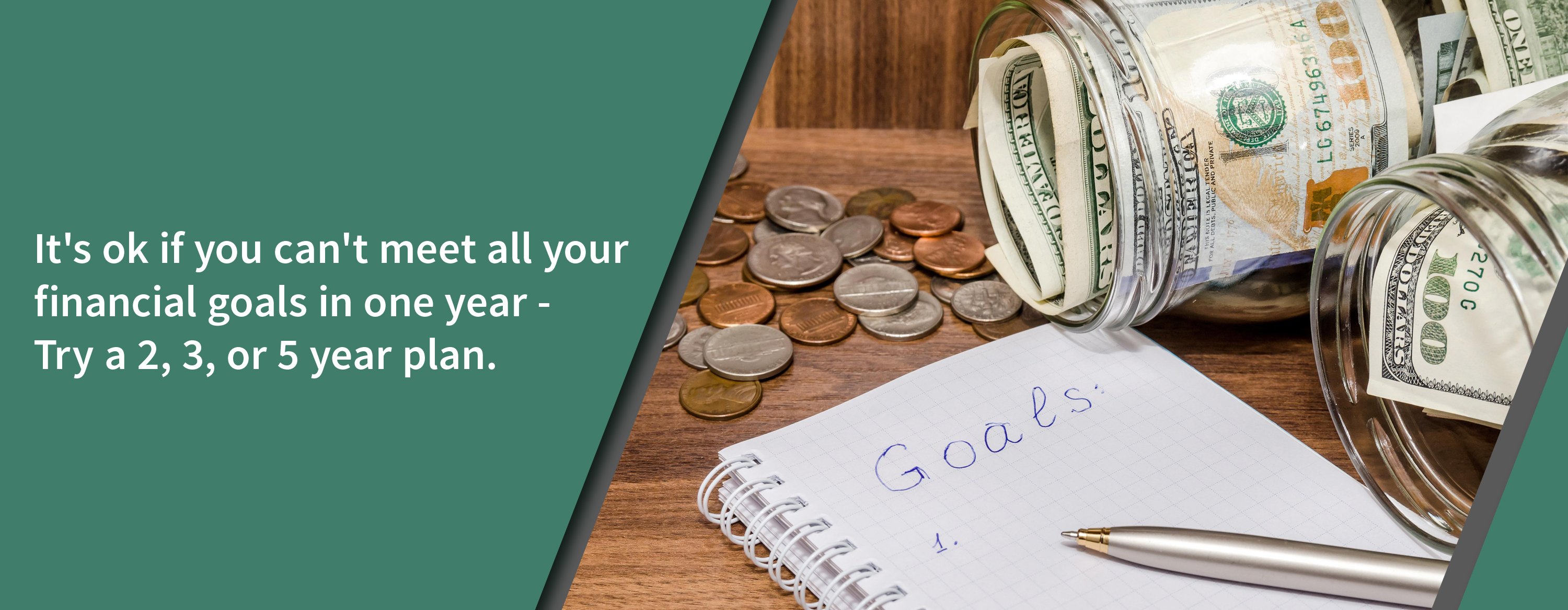Most Americans want to improve their finances,- but meeting that goal can be challenging. The key to financial health lies with having a financial plan. No matter if you’ve already set specific goals or are just taking things day by day, developing a solid financial plan — and quickly putting it in place — is one of the smartest money moves you can make.
Ready to get started on your financial plan? Here are six things you can do today to plan for a brighter tomorrow.
Setting Your Sights: Creating Achievable Financial Goals

Just as every race has a finish line, your financial path should be marked with goals of all sizes — milestones that inspire and encourage you to keep pushing forward. Don’t worry about keeping up with the Joneses. The goals you set for yourself should match your life stage, lifestyle, and vision for the future.
Whether you’re looking to buy a car, purchase a house, pay for college, or take a vacation, prepare yourself in advance to meet each goal. If you don’t think you’ll be able to achieve a specific goal this year, it’s OK to make a two-, three-, five-, or even 10-year plan. Just put something out there and go for it!
Mastering Your Money: Reviewing and Creating an Effective Budget
If you’ve already built a budget, that’s great news! Take time to review your budget once a year or more and make sure everything is up-to-date so that you know where every dollar you earn is going. Don’t skip this step, because the only way a budget works is if your spending doesn’t outpace your income.
And if you aren’t currently budgeting? That’s OK, too… but now’s the time to create a budget. A budget gives you a big-picture view of your finances and helps show where your financial goals fit in the big picture. Need help? Here are a few resources to help you get your budget going.
Revamping Your Lifestyle: Changing Your Spending Habits for the Better

If you need a few ideas to get the ball rolling and earn some extra case, financial gurus like Dave Ramsey offer plenty of advice to help get your savings account into the four digits:
- Cut back on coffee shop, drive-thru, and restaurant visits. Check this out — if you limit your $5 daily morning java purchases to just two workdays each week, you’ll save $60 a month!
- Carpool or take public transportation. Paying for a car you don’t use much? Sell it? Live near a work buddy? Switch off who drives each week, then put the money you save on gas into your bank account.
- Take the excess out of the extras. Do you really need all those streaming services or premium channels? Is there a store brand version of an item you like that tastes just as good? Make the switch and save!
Seize the Day: Start Your Saving Journey Today
Don’t have a savings account? Start one. A number of financial experts encourage everyone to have a $1,000 emergency fund on hand; money that can soften the blow when an unexpected medical issue, home or car repair, or other small emergency takes place.
Earlier this year, CNBC noted that just 56% of Americans could cover an unexpected $1,000 emergency, while a 2019 Bankrate.com article revealed that 28% of Americans had no savings at all— and that was before COVID-19 came to our doors.
Although $1,000 may sound like a huge amount of money to save, if you break it down over the course of the year, it’s an achievable goal for almost everyone. For this example, let’s assume that you get paid every other week, which means you’ll earn 26 paychecks during the year. And, we’ll assume that you’re starting with a completely empty emergency fund.
If you can save $38.47 per paycheck (or $19.24 a week), your emergency fund will hit the $1,000 mark after 52 weeks (one year). Not too bad, right?
Breaking Free: Paying Down Debt for Financial Freedom

Once you’ve reached $1,000 in your emergency fund, turn your attention toward paying down debt — it’s the fastest way to getting financially fit. With debt comes interest — additional money you pay a bank or credit card company for the privilege and convenience of borrowing money from them.
When it comes to debt repayment, there are two primary schools of thought. The first is paying the smallest balance first. Once that’s paid off, turn your attention to the next smallest, combining what you would have paid the first one with the second. This is commonly referred to as the snowball method -- one in which your payment “snowball” gets bigger and bigger until you’re attacking your final debt with a single giant payment each month.
The second is to look at the interest rate each lender is charging you, and pay those balances off in order of highest to lowest interest rate. A higher interest rate means that it costs more for you to borrow money from that lender, so attacking those first means you’re able to save on interest in the long run. You may also want to look into rates for debt consolidation, which would allow you to obtain a personal loan that could replace one or more of your high-rate balances. In essence, you’re transferring your balance from one lender to another, while saving money by way of the lower interest rate.
Securing Your Tomorrow: Investing for a Brighter Future

Now that you’ve begun building an emergency fund and paying down what you owe others, it’s time to start taking the money you work hard to earn and paying your future self — setting aside money and letting it grow (with interest) to meet some of your bigger goals or even your retirement years. Depending on what those goals might be, you’ve got lots of options that will help your money make money:
Open a savings account. Head to your local financial institution or online bank and open a savings account today. Unlike a checking account, which is tied to the debit card in your pocket or your nearby ATM machine, most savings accounts put a little more distance between you and your cash — making it harder to impulse buy. However, your money remains accessible to you, and tiered interest rates mean you can earn extra cash just for keeping your money in your savings account.
Depending on how long you plan to save (and what you’re saving for), there are different types of savings accounts offered by banks, from basic savings accounts to money market accounts (which usually have a higher interest rate but also carry minimum balance requirements) and even Christmas savings accounts that allow you to save for holiday shopping all year long! We can help you determine which is best for you and your specific needs.
Prepare for retirement. If you’re currently working, one of the easiest ways to save for the future is to contribute to an employer-sponsored retirement plan. This allows you to contribute a percentage of the money you make automatically — and “feels” a whole lot less painful than writing a check later. Also, ask if your company matches your contributions. If they do, do everything you can to qualify for those matching funds.
Here’s why — this is free money (literally) that your employer is offering you if you participate in their plan—money that can help you really boost the balance of your retirement portfolio. Let’s say your employer will match the first 4% of what you put into your employer-sponsored 401(k) plan. If you budget and are able to contribute 4% of your own money — that’s eight percent of your salary being poured into your retirement plan!
We’re here to help
At Jefferson Security Bank, we want to partner with you to enrich your lives and the communities in which we all live, work and play. For more information about financial planning, opening a savings account, or any other money matters, give us a call at 304-876-9000, send us a message, or stop by one of our Shepherdstown, Martinsburg, Charles Town, Inwood or Sharpsburg locations today.

